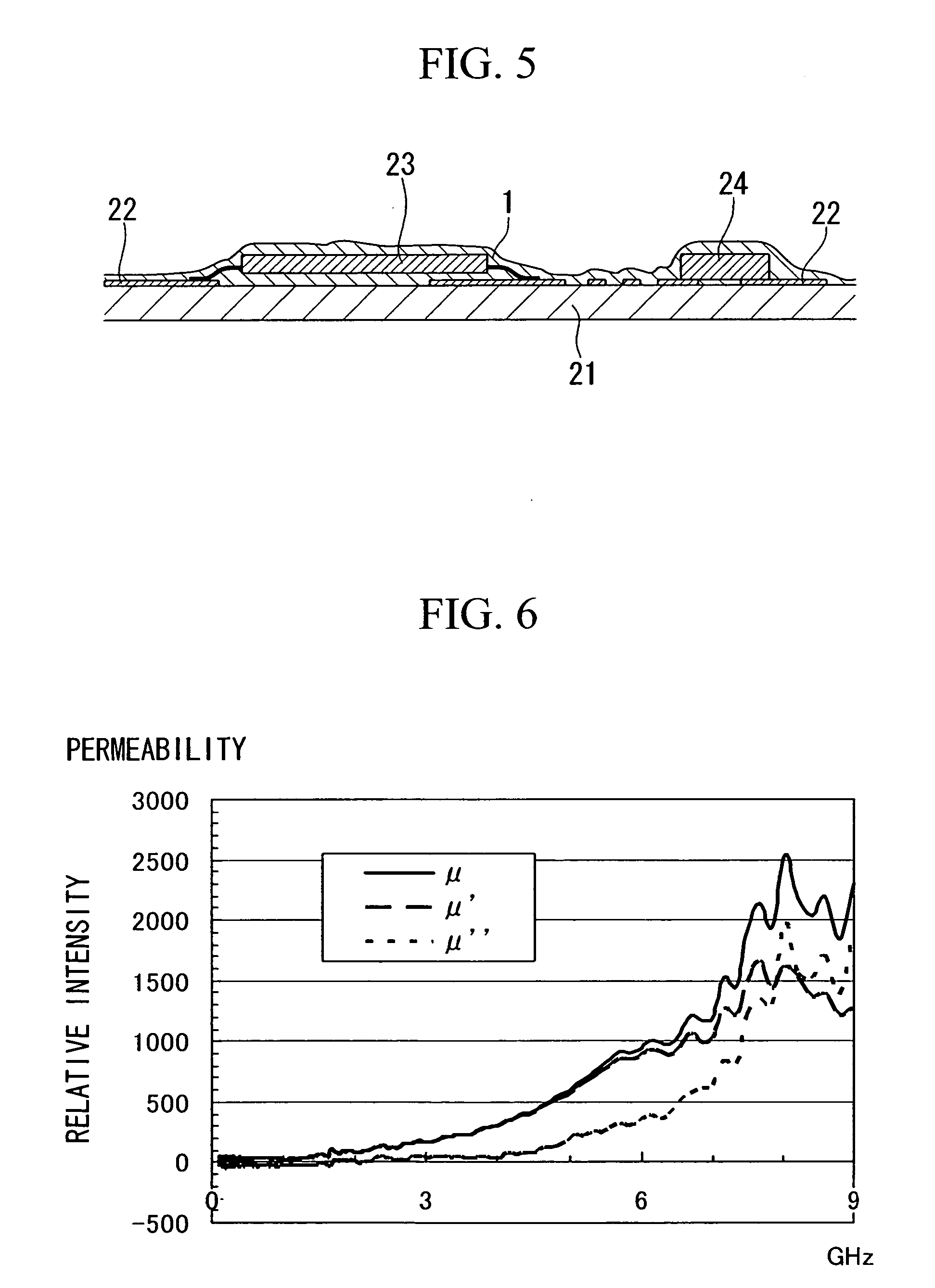Electromagnetic noise suppressor, structure with electromagnetic noise suppressing function, and method of manufacturing the same
a technology of electromagnetic noise and suppressor, which is applied in the direction of magnetic bodies, inductances, non-metallic protective coating applications, etc., can solve the problems of difficult stabilization of iron nitride crystal structure, inability to prove sufficient electromagnetic noise suppressing effect over the entire sub-microwave band, and increasing problems, so as to achieve convenient manufacturing, efficient suppression of electromagnetic noise, and easy structure manufacturing
- Summary
- Abstract
- Description
- Claims
- Application Information
AI Technical Summary
Benefits of technology
Problems solved by technology
Method used
Image
Examples
example 1
[0090] A silicone rubber that had been vulcanized having a thickness of 15 μm (elastic modulus in shear of 1×107 Pa at normal temperature containing wet silica) was provided as the binding agent on a polyethylene phthalate film used as the support layer having a thickness of 12 μm (elastic modulus in shear of 3.8×109 Pa at the normal temperature), and thereon a composite layer was formed by sputtering Fe—Ni-based soft magnetic metal to an equivalent thickness of 20 nm by physical vapor deposition of the opposing target type magnetron sputtering process, thereby to obtain the electromagnetic noise suppressor. Sputtering was carried out by applying a low negative voltage so as to impart energy of 8 eV to the vaporized particles while maintaining the substrate at the normal temperature.
[0091] Then a thin portion was sliced by means of a microtome from the electromagnetic noise suppressor thus obtained and, after polishing the cut surface by ion beam, cross section of the composite lay...
example 2
[0092] An epoxy resin of B stage having a thickness of 25 μm (elastic modulus in shear of 8×106 Pa before curing and elastic modulus in shear of 2×109 after curing) was provided as the binding agent on a polyethylene terephthalate film that had been subjected to mold-release treatment and used as the support layer having a thickness of 12 μm, and thereon a composite layer was formed by depositing Fe—Ni-based soft magnetic metal to an equivalent thickness of 10 nm by physical vapor deposition of the opposing target type magnetron sputtering process. Sputtering was carried out by applying a low negative voltage so as to impart energy of 8 eV to the vaporized particles while maintaining the substrate at the normal temperature. The epoxy sheet was removed from the polyethylene phthalate film and was cut into halves, and the epoxy sheet were placed on the other so that the composite layers were stacked alternately. The stack was heated to 40° C. for 6 hours then 120° C. for 2 hours so as...
example 3
[0093] Metal Ni was deposited to a thickness of 30 nm on one side of a polyimide film used as the support layer having a thickness of 12 μm, and provided on the other side was vulcanized electrically conductive silicone rubber having a thickness of 7 μm (elastic modulus in shear of 2×107 Pa at the normal temperature with 15% by weight of carbon black included) as the binding agent. Then composite layers were formed on the top and bottom surfaces by depositing a Fe—Ni-based soft magnetic metal to equivalent thickness of 20 nm by physical vapor deposition of opposing target type magnetron sputtering process, thereby to obtain an electromagnetic noise suppressor. Sputtering was carried out by applying a low negative voltage so as to impart energy of 8 eV to the vaporized particles while maintaining the substrate at the normal temperature. Relative intensity of μ″L of the imaginary part of the complex magnetic permeability was 180 and relative intensity of μ″H was about six times the va...
PUM
| Property | Measurement | Unit |
|---|---|---|
| magnetic resonance frequency | aaaaa | aaaaa |
| magnetic resonance frequency | aaaaa | aaaaa |
| resonance frequency | aaaaa | aaaaa |
Abstract
Description
Claims
Application Information
 Login to View More
Login to View More - R&D
- Intellectual Property
- Life Sciences
- Materials
- Tech Scout
- Unparalleled Data Quality
- Higher Quality Content
- 60% Fewer Hallucinations
Browse by: Latest US Patents, China's latest patents, Technical Efficacy Thesaurus, Application Domain, Technology Topic, Popular Technical Reports.
© 2025 PatSnap. All rights reserved.Legal|Privacy policy|Modern Slavery Act Transparency Statement|Sitemap|About US| Contact US: help@patsnap.com



